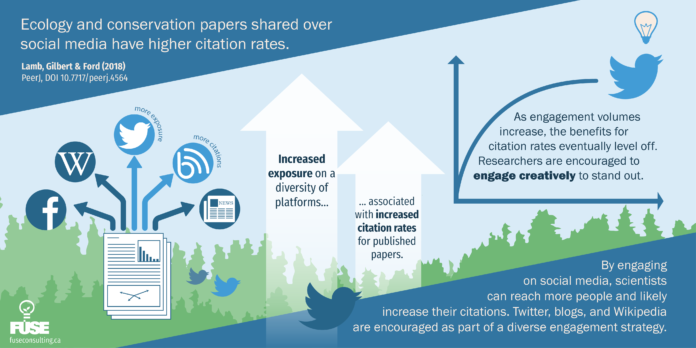Think time spent on Twitter is time wasted? Not for scientists trying to spread the word about their latest discoveries, new research suggests. In fact, talking about science on social media might be an effective strategy for scientists trying to engage both fellow scientists and the general public in their work.
Clayton Lamb, a PhD candidate at the University of Alberta, found that papers published in his field that are shared on social media tend to have a higher citation rate than those that aren’t. The work was published this past April in the journal PeerJ.
Lamb and his co-authors frequently share their science on Twitter and other social media platforms, and they were curious if this was having an influence on the reach of their work.
“We’re putting time and effort into these sorts of things,” says Lamb, “hoping that the science goes further in the academic community, that it gets out to the public and that our science is of more value – reaching more people.”
Lamb and his colleagues collected data from just over 8,000 ecology or conservation biology journal articles published sometime between 2005 and 2015 and looked to see if there was a relationship between how often an article was found on social media and how often that article was cited in other research articles.
What they found was a strong correlation between being shared on social media and citation rate – articles that were popular on social media tended to be popular in the scientific literature too. Encouragingly, their results suggest that researchers don’t need to hire a social media team to reap the academic benefits.
A small boost in social media attention were associated with substantial jumps in citation rates – an effect that was most pronounced for articles with few citations. Twitter and other platforms can shine a spotlight on otherwise obscure articles, it seems.
Lamb speculates that many scientists are using various social media platforms as one way to keep up with current research. With new work published each day, it is difficult to stay on top of what’s relevant in your field. If an article becomes visible on Twitter, more scientists are likely to notice, and cite it in their research.
“I find that it’s hard to keep up with the papers that come out in my field, they’re coming out daily,” says Lamb. “I’m sure there’s a lot of good science published even in the last month that I just haven’t heard of yet.”
Lamb, however, cautions that his results reveal a correlation, and more work is needed before a causal relationship can be established.
Academic benefits aside, Lamb still suggests that more scientists should consider using Twitter, arguing that the platform provides a unique opportunity for the public to interact with scientists. Lamb says that while he follows and engages with a lot of fellow scientists, he’s noticed a large portion of his following are non-scientists.
“[Twitter] gives the public an opportunity to engage with me and other scientists in an unprecedented fashion”, explains Lamb, “There’s not another forum where you can just chat with a scientist like you can on Twitter.”
“It’s nice to break down those academic and research walls,” adds Lamb.
So, scientists and non-scientists, go waste time on Twitter.








































